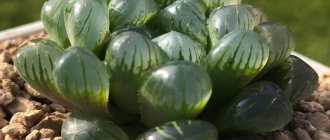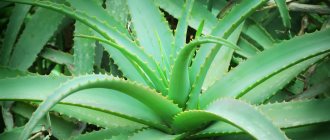The demand for cacti as decorative flowers is constantly growing. They are inexpensive, do not require complex care, are resistant to diseases and pests and take up little space, so they are suitable for any apartment or area. Flower growers planning to work with them should find out the characteristics of the cactus species of interest and determine the varieties of plants already purchased. This will help you choose the right watering and fertilizing scheme for each variety.
The soil
A comfortable environment for cacti is loose, slightly acidic soil that allows air and water to pass through well. A mixture of coarse river sand, leaf humus and turf soil in equal proportions would be ideal. Stagnant water is not allowed for cacti. Therefore, it is important to make good drainage at the bottom of the pot, consisting of brick chips, expanded clay or gravel.
Problems in care
The main problems with a cactus are almost always related to water. If your plant becomes shriveled or soft, it needs water. Water thoroughly and then drain off excess water. If you don't do this and your plant sits in water for a significant period of time, it may begin to droop or develop dark pulp at the base. This means it begins to rot. If this happens, you may not be able to save the original plant, but you may be able to grow a new plant by taking a cutting from an unaffected area.
Landing
Before transplanting the cactus into another pot, you need to stop watering for a few days - this will make it much easier to remove the root from the ground. After the drainage layer, 1/3 of the soil mixture is poured into the new container. Next, carefully immerse the roots in it and sprinkle with the remaining soil. The root collar is sprinkled with river sand.
In order for the wounds of the root system to heal after transplantation, the soil is not moistened for several days. It is enough to replant an indoor cactus only once every couple of years.
Lophophora
The succulent Lophofra, which belongs to the cactus family, according to various sources, has from 1 to 4 species. All of them are native to the semi-deserts of Mexico. The main types of Lophofra: Williams, Fritsch, Spreading, Jourdan. A feature that makes it difficult to grow this cactus is its juice. In small quantities it is used as a medicine, but an overdose causes hallucinations similar to drugs. Therefore, these cacti are very rare.
Lophophora needs bright light, but it must be diffused. Avoid exposure to direct sunlight, as this will slow down the plant’s growth, and unsightly spots will form where the rays hit.
In summer, watering should be done 1-2 days after the substrate has completely dried. By autumn, watering is reduced, in September the temperature is reduced and the cactus is not watered until March, since rot forms faster in cool air. Additional air humidification is not required.
Temperature fluctuations when growing Lophofra cactus are very suitable for novice gardeners. Prefers moderate temperatures in our rooms, but can easily tolerate increases up to 40 degrees! During the dormant period (autumn and winter), it is better to place the plant in a cool place with a temperature not exceeding 10 degrees. Lophophora is planted in a tall pot with a good layer of drainage. The top is covered with fine gravel, especially the root collar.
Rainbow Hedgehog Cactus
This species is cylindrical or oval in shape, up to 45 cm tall. It is impressive with its color range - pink and purple shades.
This cactus is quite comfortable without shading from the bright sun, on the south and west side. Echinocactus favorably tolerates dry air, but also does not mind periodic spraying with sufficiently warm water.
This breed has an extremely fragile root system, so the inevitable replanting must be extremely careful.
Strauss Cleistocactus
Belongs to the Cactus family, there are 50 species. Its homeland is South America and Uruguay. The most common three species in indoor floriculture: Strauss's Cleistocactus, Winter's Cleistocactus, and Emerald-flowered. All types are flowering and very decorative.
Also read: Epiphyllum - forest cactus with beautiful flowers
He loves light very much and needs it throughout the year. It is better to place the cactus on a south window. In summer you can place it in direct sunlight in fresh air. Each species has distinctive flowers.
Watering should be done every time the soil substrate is completely dry. The substrate should be made moisture-permeable and loose. In summer, when the temperature ranges from 22 to 28 degrees, water more often, and in winter, the temperature is reduced to 15 degrees, and watering is reduced, carefully monitoring the condition of the soil.
Opuntia microdasys (Prickly pear)
It is highly undesirable to touch any type of prickly pear. Its miniature spines with jagged ends prick very painfully. Prickly pears grow up to 30 cm and come in a variety of shapes.
In summer, the cactus is watered abundantly, but during periods of extreme heat, watering is reduced and done only in the evening. In this case, moisture should not get on the stems.
Melocactus
Melocactus is sometimes called Melon Cactus and belongs to the Cactus family. Originally comes from the coast of Mexico. There are 33 species in total. Naturally, several have been cultivated. At the tops of the ribbed round trunks there is a cephaly - a modified shoot: felt-like or bristly. Melocactus has an interesting feature - having reached its limit, the trunk stops growing, but the cephaly begins to grow, on which flowers are formed.
Melocactus is a difficult cactus to grow, especially for beginners. You can try to grow the following types of melocacti: Azureus, Matanzanus, Communis from seeds.
This plant has shallow roots, so it needs to be planted in wide and flat containers. Most melocacti need high air humidity; it is more important than watering the plant. When watering, you should always drain the water that has seeped through the loose substrate pan.
Like all cacti, it loves sunny places and from April to September the temperature should be between 22-26 degrees, from October to March - 12-15 degrees Celsius.
Trichocereus candicans
Can grow up to 1.5 meters. It features white, funnel-shaped, fragrant flowers.
Depending on the species, the stem can grow vertically or obliquely. The length of the spines on the ribs reaches 4 cm, in the center - 2 times longer.
The plant is very hardy and unpretentious, gaining height and expanding easily with plenty of sunlight, warmth and regular watering.
Hylocereus
A large forest cactus from the cactus family, it has many thin aerial roots with which it attaches to trees or other supports. Its three- or tetrahedral stems reach a length of up to 10 meters. Only one species is cultivated - wavy.
Good sunlight stimulates normal growth and begins to bloom in the third year. Flowers are naturally pollinated and produce edible fruits. In indoor conditions, the plant is placed in the most illuminated place and, if possible, in direct sunlight. Then the flowers turn out larger and brighter.
The temperature is suitable 22-28 degrees in the spring-summer period; during winter dormancy, the temperature should be reduced to 15 degrees, but not lower. Water the cactus with warm, preferably filtered water, sparingly, without over-wetting the soil substrate.
Holiday Cactus (Christmas or Schlumberger)
The plant impresses and pleases with its beautiful flowering in winter, which is unusual for cacti.
Therefore, it is in winter that Schlumberger will need intensive watering. For such a cactus, diffused sunlight is more acceptable. The palette of shades of flowers 7-8 cm long can be very different.
Ferocactus
Ferocactus is part of the large Cactus family. Its natural habitat is quite extensive - from North America, Mexico to South and South-West America. There are a lot of species of Ferocactus, we will note just a few that are the most convenient for breeding, even for beginners: Acanthus, Coloratus, Broad-needle, Ford, Imeri, Porcupine, Powerful.
The plant loves the sun both in summer and winter. Therefore, if there is a place for the cactus on the north window, then it will need lighting on winter evenings.
Also read: Zygocactus - Decembrist: homemade varieties with photos and care for them
If the soil is selected correctly, then in spring and summer you need to water as soon as the soil substrate is completely dry; during the dormant period, watering is reduced even more. Water with soft water: rain or melt water, warmed to room temperature. You can use filtered water.
Mammillaria (Mammillaria)
This plant has up to 500 varieties. Mammillaria are covered with long soft spines, like hairs. The stems come in spherical or cylindrical shapes.
Their characteristic difference from other representatives is the presence of many papillae. Flowers of purple, white, and red tones grow from the axils located between the papillae.
Diseases and treatment
Diseases in echinocacti are mainly caused by excess moisture or waterlogged soil. Eliminating the problem should begin by reducing watering. They should be rooted immediately.
Diseases and parasites that often affect Echinocactus are:
- spider mites. The plant must be treated with an acaricidal agent, which must be used to treat the cactus for two weeks, once every 7 days.
- mealybugs. To combat parasites, use a soap solution with alcohol, which is used to treat the plant daily after washing the cactus under running water.
- scale insect. For treatment, you need to treat the affected areas with cotton pads soaked in alcohol or spray the plant with Actellik solution twice a month.
Compliance with the rules of care will help prevent the development of diseases in echinocacti and provide all the necessary conditions for its proper growth and flowering. It is especially important to know how to water a flower so that the roots of the plant do not rot.
Notocactus ottonis (Notocactus Otto)
Flower growers grow this species not so much for the sake of flowering, but for the interesting structure of the stem with pronounced ribs, on which hard spines look very nice.
Over time, large glossy yellow flowers appear, the diameter of which reaches 8 cm. The result is an expressive contrast against the bright green background of the stem, which adds even more attractiveness to this breed.
Wild cacti
In the wild, cacti are impressive in their size and diversity. Among them there are real monstrous giants. Some are even edible and used to make drinks.
Aporocactus
A branched cactus growing as entire bushes in the Mexican deserts. It is not very resistant to high temperatures, but it blooms beautifully.
Photo: botanichka.ru
Prickly pear
Prickly pear is easily recognized by its flat, oval stems that resemble broad leaves. They also grow in bushes up to 4 m in size. Prickly pears are covered with thorns, including small and almost invisible ones.
Photo: dp32.ru
Hylocereus
An original creeping or climbing cactus with shoots resembling vines. It is common in tropical regions and grows as spreading shrubs up to 3 m in height.
Photo: semenatop.ru
Echinopsis
A large group of desert cacti with round, thick stems and sparse hard spines. Young Echinopsis look like a ball, but with age they stretch out.
Photo: pinterest.ru
Mammillaria
A common Mexican species, the shoots of which are densely covered with convex papillae, from which small fleecy needles grow. This is a compact cactus with bright and abundant flowering.
Photo: pocvetam.ru
Astrophytum
Unusual cacti with fancy ribbed stems and very beautiful flowering. In spring they are covered with large buds, reliably protected by powerful spines.
Photo: waysi.ru
Echinocactus
One of the leaders in length and impressiveness of needles. Young plants grow in a ball, but become elongated with age. In the natural environment, the height reaches 2-3 m. The ribbed shoots are densely covered with spines. There are known specimens that are about 500 years old.
Photo: waysi.ru
Cleistocactus
Cleistocactus has unusual straight stems that are very elongated and can droop towards the ground over time. The shoots are densely covered with thin whitish or yellow spines.
Photo: stocvetov.ru
Ferocactus
A spectacular genus of spherical cacti up to a meter in diameter. Buds bloom at the top of mature plants. Ferocacti have become very popular among gardeners due to their colorful spines.
Photo: stocvetov.ru
Aylostera
A mountain species of cacti growing in Argentina at an altitude of over 3 km above sea level. The rounded shoots are very small, up to 6 cm in diameter, but they grow abundantly with children, due to which they grow in width.
Photo: botanichka.ru
Lepismium
A rare forest epiphyte with long drooping stems, at the end of which flowers bloom. The ribbed edges of the segments remind us that there were once spines there.
Photo: pinterest.ru
Gerbera (70 photos): types and features of care
Rebutia miniscula (Tiny rebutia)
These cute little cacti are spherical in shape with a diameter of no more than 10 cm. Tiny Rebutia differs from other similar species in the placement of flowers - not at the top of the stem, but at its very base.
Flowers, as a rule, have a pink, orange, red tint, and even the golden color of the spines of the rebutia makes it especially decorative.
This cactus is very favorable to dry air, but requires mandatory spraying in the morning from a spray bottle. Basically, the plant requires the same conditions as other indoor cacti.
Do you have cacti at home? What types are your favorite?
Characteristics
A large family of cacti from the genus Opuntia has three hundred species. The birthplace of these plants is the continent of America (New World), but they were introduced and have taken root well in tropical and subtropical conditions. Their main features are:
• the ability to survive in difficult climatic conditions;
• minimum water requirement;
• no burns when the location is oriented to the south.
Characteristics:
• flattened leaf blades are succulent and oval (ovoid or oblong type);
• juicy leaves of rich green color;
• stalks are segmented or leaf-shaped;
• rudiments of leaves appear in the areoles on young stems, which fall off underdeveloped;
• height is variable: from 6 m in nature to 0.6 m at home.
Each variety has its own individual characteristics, as well as growing requirements.
Without needles
The vast majority of succulents are protected by beautiful needles. Scientists call them modified leaves that are adapted to survive at abnormally high temperatures.
With colored needles
There are many varieties whose spines can be purple, silver-gray, yellowish or white. The most common are silver-gray spines.
Note! The color of the thorns depends on the species characteristics of the plant. To ensure that their decorative qualities are not lost, plants need to be given proper care.
If a person in a store saw cacti with red needles, then, undoubtedly, another person was involved. Painting the spines of a succulent is not difficult, and most importantly, it does not negatively affect the health of the ornamental crop.
Ornamental plants with colorful needles
A small amount of food coloring is added to the fertilizer or water for irrigation and the resulting solution is watered over the crop. After a short period of time, the spines will absorb the dye and change color.
Note! You can repeat the procedure at home.
Most plants of this species have needles of medium length, but there are representatives whose spines reach 5 cm in length. We are talking about:
- ferocactus;
- Echinocactus;
- Carnegie.
Cactus with long needles
Due to the large size of the thorns, care, planting and replanting are quite problematic.
Without needles
There are also representatives of the flora that lack spines.
- Epiphyllum is a long thornless cactus that blooms very beautifully. The color of the petals of the inflorescences can be bright red, orange, pink, purple or even mixed.
- Hatiora visually very much resembles a coral bush, despite the fact that it is a representative of the cacti.
Cactus without needles
It is also worth mentioning rhipsalis, which has much in common with hatiora. Only its stems are longer and slope downward.
Most types of cacti are protected by needles. These are modified leaves adapted to survive in the heat.
With colored needles
The spines can be of different colors: white, yellowish, silver-gray. The latter are the most common. Each natural color of thorns is determined by species characteristics. In order to maintain the appearance of your pet, you should provide it with suitable care.
If in a store all eyes are focused on a cactus with red needles, then, without a doubt, a person has worked here. Painting the thorns of a succulent is quite simple; this procedure does not harm the plant. Food coloring is mixed into water for irrigation or fertilizer, and the flora is fed or watered with this mixture. The cactus will absorb the paint and change the color of the thorns.
Note! You can tint the color of cactus needles yourself at home. All thorn-bearing species are suitable for this.
With long needles
Most species of cacti have medium-length needles. There are species in which the length of the prickly thorn can reach 5 cm, these are:
- Echinocactus;
- Carnegie;
- Some types of mamillaria;
- Ferocactus;
Ferocactus - And many others.
READ MORE: Perennial low-growing carnation: planting and care
These representatives of the flora exist without needles, for example:
- Hathiora. Despite the fact that it looks more like a coral bush, it is still a cactus.
- Rhipsalis. It is similar to hathiora, but its stems are downward-growing and longer.
- Epiphyllum. This cactus is also thornless and blooms very beautifully. Flowering can be purple, pink, orange, bright red or a mixture of colors.











